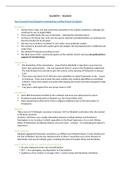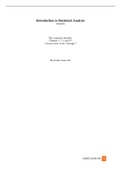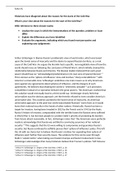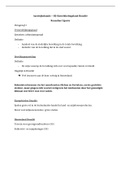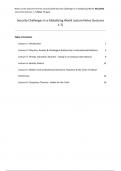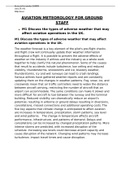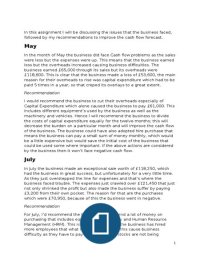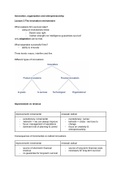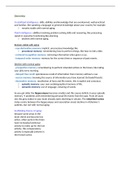How Successful was Elizabeth in maintaining a unified Church of England
ELIZABETH I
During Mary's reign, she had conformed outwardly to the Catholic settlement, although she
continued to use an English Bible
There was little doubt she was a Protestant – educated by reforming tutors
At Mass on Christmas day 1558, the new queen rejected transubstantiation, by ordering that
the Host should not be elevated
She was not as strident as Edward VI, but rather more politically realistic
She wanted to proceed with caution given the dangers she had experienced in childhood and
under Mary
She allowed Protestant preaching at court
She liked some of the ceremonial aspects of the Catholic Church and was not particularly in
support of married clergy
PARLIAMENT
The dissolution of the monasteries meant that by Elizabeth’s reign there were more lay
peers than spiritual peers – this was important when it came to the Elizabethan settlement.
The exile Richard Cox returned to give the sermon at the opening of Parliament in January
1559
There were only about 20-25 MPs who were identified as radical Protestants in the House
of Commons. There was at least the same number who could be identified as committed
Catholics. Many were simply concerned with keeping the church land they had gained under
Henry VIII
9 lay peers voted against the new prayer book in 1559
THE PEOPLE
Some 800 Protestants had fled to the continent and were now determined to return
Protestant books dedicated to Elizabeth e.g. the Geneva Bible 1560
Many people had conformed to Mary’s religious settlement due to the persecution of
Protestants
BISHOPS
There were 10/13 bishopric vacancies in January 1559 so Elizabeth could select who she wanted
to fill these vacancies
At Easter 1559 there was a public disputation between Catholic bishops and Protestant
theologians to try to reduce Catholic opposition to the Royal Supremacy. As a result, Bishop
White of Winchester and Bishop Watson of Lincoln were arrested for challenging the Queen’s
Supremacy
PRIVY COUNCIL
Elizabeth appointed Protestant councillors e.g. William Cecil Nicholas Bacon, Francis Knollys and
the Earl of Bedford. But she also retained some of Mary’s councillors such as the Marquis of
Winchester and several Catholic peers, including the Earls of Arundel, Derby and Pembroke
WHAT WERE ELIZABETH'S OWN RELIGIOUS BELIEFS:
No clear statement of her vies was left behind
BUT -> her upbringing = predisposition to Protestantism
Legitimacy of her mother's marriage 1533 -> hand in hand with the Break with Rome
, Elizabeth's right to the throne -> opposition to the papacy
Boleyn faction -> interest in Lutheranism
Matthew Parker = Anne's chaplain + Elizabeth's tutor -> becomes Archbishop of Canterbury
Later education -> Catherin Parr (Protestant 1543-7) brought Elizabeth back to court
HOW SUCCESSFUL WAS SHE IN MAINTAINING A UNIFIED CHURCH OF ENGLAND:
What form would the Church take:
o Anglo-Catholic Church
Church whose doctrines + practivces remained Catholic even though it rejected
papal supremacy
o Moderate Protestant Church
Similar to that implied by the Act of Uniformity 1549
o Radically evangelical Church
As implied by the Act of Uniformity 1552?
Religious Settlement
RS established by 1559 Act of Supremacy + Uniformity (passed with considerable
opposition in HoL)
Act of Supremacy 1559 + Act of Uniformity 1559
EI declared herself supreme governor of the Church - showed she would be more tolerant
Set out rules of religious practice + worship + introd new prayer book
Protestantism made England's official faith but kept some catholic traditions
Revoked the Heresy Acts + Papal supremacy
Imposed oath on all clergy + office holders to enforce conformity to the new Prayer Book
Everyone to attend church on Sunday + other holy days - fines for those who didn’t
The Royal injunctions 1559
Drafted by Cecil ordered clergy to:
o Observe royal supremacy + preach against papal authority
o Condemn images, relics + miracles
o Preach only with permission - licences
o Marry only with permission
o Observe the Ornaments Rubric
Thirty-Nine Articles 1563
Passed through convocation 1563 + given statutory auth 1571
Bishops who drew them up aimed to present a united, protestant front against the
Catholics led by Matthew Parker
Sought to define the difference between the CofE + Catholic Church
Broadly supportive of reformed doctrine using ambiguous language
Historian Doran 'Something of a hybrid'
At times, Parker's vision of reform was not shared by the queen
o They clashed over issue of married clergy
CofE becoming more Calvinist in official doctrine but remained ½ reformed in its structures
They used the 42 articles as a basis under direction of Thomas Cranmer
o 42 articles overturned under Mary but Elizabeth favoured reform
, The articles are full of ambiguous language allowing for broad definition of faith that
excluded Roman Catholics but included spectrum of Protestant belief BUT firmly
established Anglican church with her as head
Articles rejected catholic beliefs e.g. Transubstantiation
PROBLEMS THE RELIGIOUS SETTLEMENT SOLVED
Elizabeth gained control of Church wealth
The Elizabeth Prayer Book
It lasted
PROBLEMS THE RELIGIOUS SETTLEMENT DID NOT SOLVE
Doctrine -> 1 doctrine not established
o Caused confusion + dismayed protestant reformers who had hoped for vigorous
theological debate leading to statements of belief
Clergy -> loss of leading Catholic clergy members meant Protestants had to be appointed
o Financial + religious confusions meant there was a shortage of properly qualified
clergy
o This + Crown extracting worth of church meant it was approaching poverty
Pope Pius IV -> expected to excommunicate EI
o Fear of Catholic crusade led council to make early overtures to Protestant German
princes in hope of establishing religious alliances
RELIGIOUS DEVELOPMENTS BETWEEN 1559-63
Catholic concessions
1559 Old vestments allowed to be worn during services + communion table to stand where
altar stood
1560 Latin edition of Prayer Book allowed requiem celebrations for dead
1560 crucifix + candles restored to altar + tried to re-establish full Catholic vestments
1561 evicted wives + children of higher clergy from colleges + cathedral closes rather than
banning clerical marriages
Penalties for recusants lessened
WHY:
Religious stance was not as important as international relations was - Spanish armada
+MQS linking with France & looking to get to throne
religious confusion/conflict had dominated her predecessors reigns often with negative
outcomes - not important
Security of throne = more important
HoL = Catholic HoC = Puritan Choir
Historiography:
Neale - Dominant interpretation - 1950
o EI faced pressure form radical clergymen + allies in HoC - 'Puritan Choir'
o Had to accept a more protestant settlement that she had wanted
Norman Jones 1982 - challenges
o Argued EI + ministers faced political opposition from Catholic bishops + conservative
peers in HoL rather than Puritan Choir
o Bishops + Conservative peers grudgingly accepted the restoration of royal supremacy
they provided much more opposition to the uniformity bill, which was only passed in
Lords by 3 votes
, Why did the Queen retain an episcopal system of Church government?
Episcopate – the bishops; episcopal – a Church governed by bishops
Responsible for the organisation, administration and supervision of the clergy
EI wanted to use her bishops to control the Church, and therefore, her subjects
This would also help if Elizabeth needed (for foreign policy’s sake) to minimize the
differences between her Church and continental Church
Traditional
Marian bishops encouraged to stay in their positions, but they refused to swear the Oath of
Supremacy, so they were deprived of their offices
Elizabeth turned to those who had been Protestant exiles during Mary’s reign
o William Cecil was influential in the appointments that were made
o Attempt to retain Catholic bishops show Elizabeth was interested in presenting
image of religious continuity and to avoid confusion?
o Was she unrealistic hoping Marian bishops would enforce Protestantism?
o Or did she think the bishops would be willing to make these compromises due to
their in-built loyalty to the monarch?
Using exiled men was therefore risky; how did she know they would be loyal?
o The problem was that they saw the Elizabethan Settlement as a starting point and
expected further reforms
Elizabeth, however, saw her Settlement as the conclusion
The Exchange Act 1559 meant that the Queen was given the right to exchange church
property in her possession for non-spiritual property in the possession of the church
It allowed the Queen to take land and buildings from the Church and force Bishops to pay
rent, adding considerably to the Queen's purse
Protestant laymen were happy with this stripping of wealth; they hoped this method would
curtain power of bishops (some had been energetic about burning Protestants under Mary)
The Act also put pressure on the bishops to grant leases to nobility on favourable terms as
to refuse someone who had the queen’s backing would be dangerous
Elizabeth envisaged her bishops less as generals leading armies of Protestant shock-troops and
more as subservient civil servants whose task it was to promote uniformity on the model approved
by her, and whose incomes might be tapped whenever the Queen felt necessary.
What do the Injunctions, Visitations, Crucifix and Vestiarian controversies suggest about the role
of the Queen in shaping the religious settlement in the years after its inception?
Elizabeth sought to establish a basically Protestant settlement of religion, which
nevertheless emphasised elements of continuity with the Catholic past in the interests of
the stability of the crown
Royal Supremacy (right of the monarch to government the Church of England)
Processions banned
Monuments to ‘fake’ miracles banned
Pilgrimages forbidden
Recusants (Catholics who refused to go to attend services of the Church of England)
denounced to the Privy Council or to the JPs
Preaching was limited; could only take place with official permission and licenses; Master of
Arts degree required; these preachers few and far between
Elizabeth feared unlicensed preachers could be disruptive, critical of her government and
dangerous to her personal authority over the Church


